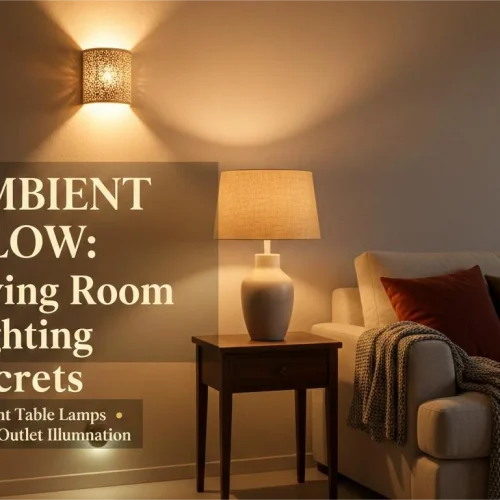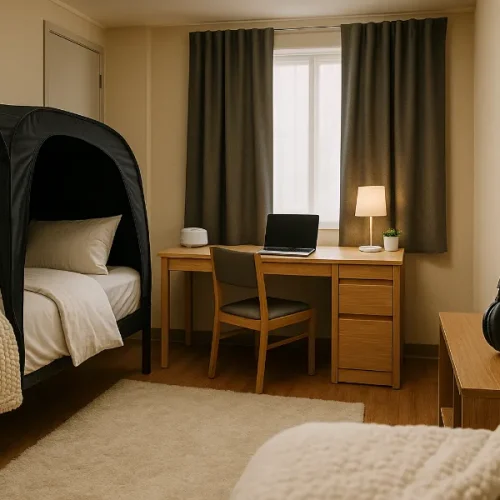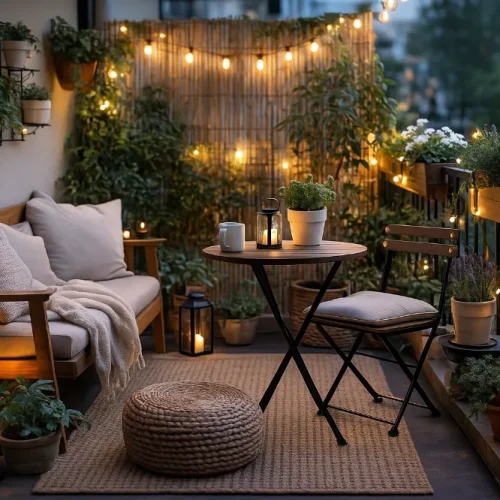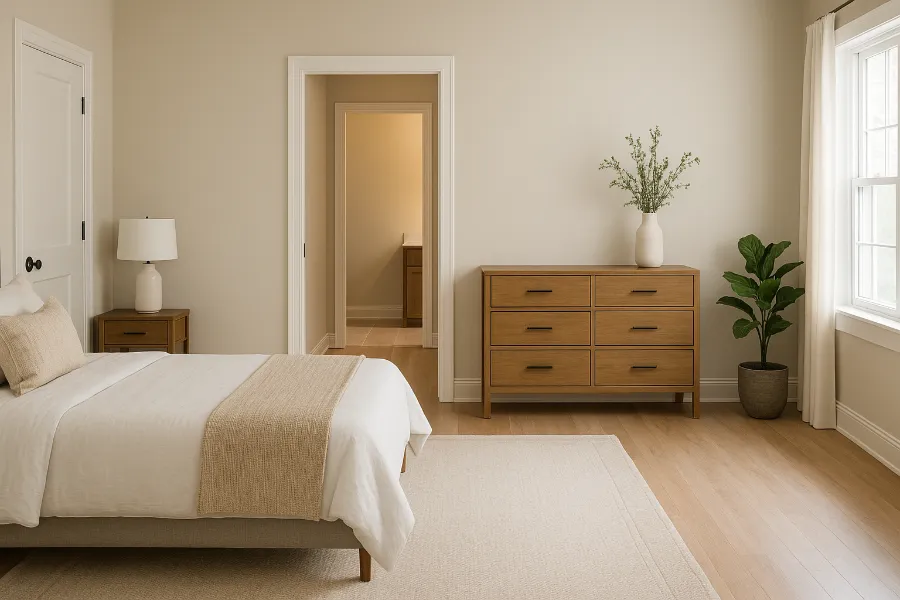
A bedroom is more than a place to sleep. It’s the final exhale of the day, the soft landing space, the quiet world you return to when everything else feels loud. Because of that, the way a bedroom is arranged has a powerful effect on how it feels. Some rooms instantly seem calm and inviting, while others feel cluttered, cramped, or strangely off-balance even when they’re clean and furnished with care. The difference usually comes down to balance and visual proportion.
Balancing a bedroom layout is part art, part practical sense, and part understanding how the human eye reads space. Interior layout choices have a strong influence on how people feel in a room, and this idea is widely recognized in design fields. Anyone can place a bed and call it done. But creating a room that feels comfortable, grounded, and visually pleasing takes a bit more intention. The goal is not perfection. It’s harmony. It’s about helping the room “make sense” so your mind can rest. Below are thoughtful, approachable strategies for achieving balance and proportion in any bedroom, whether it’s spacious, tiny, or somewhere in between.
Understanding the Role of the Bed as the Anchor
The bed is the anchor of the bedroom. It is usually the largest and most visually dominant object in the space, and everything else works in relation to it. In rooms that feel “off,” the bed is often the culprit either placed awkwardly or sized incorrectly for the space.
A good rule: the bed should go on the wall you see first or most naturally from the doorway. This makes the room feel grounded and intentional, preventing the space from feeling like there’s no focal point. If the bed is not on a full wall and instead is pushed into a corner or placed under a window in a way that forces uneven space around it, the room can feel visually unbalanced. Whenever possible, aim for the bed to sit centered along a solid wall with open access on both sides.
Considerations when anchoring the bed:
- Leave at least 18 to 24 inches between the bed and walls or furniture.
- Avoid pushing one side of the bed flush against a wall unless space is very limited.
- Ensure the bed position allows easy access to lighting and outlets.
Once the bed is correctly placed, every other piece becomes easier to position.
Choosing the Right Bed Size for the Space
Visual proportion begins with selecting a bed size that suits the room. A king-size bed in a small bedroom can dominate the space, making it feel cramped. Conversely, a very small bed in a primary bedroom may make the room feel oddly empty or unfinished.
Simple scale guidance:
- Small rooms: full or queen-size beds work well.
- Medium rooms: queen or king depending on layout.
- Large rooms: king or a king with additional seating areas.
Also pay attention to bed height. A tall bed with a bulky mattress can feel heavy in a small room, while a low-profile bed makes space feel larger.
The bed sets the tone for everything else.
Symmetry vs. Asymmetry in Design Balance
Symmetry is popular in bedroom layouts because it naturally feels stable and calming. The classic setup of: bed centered against wall + matching nightstands + matching lamps, works for a reason. The eye finds comfort in mirrored spacing.
But asymmetry is also a tool especially in smaller rooms, studios, or rooms with architectural quirks like angled ceilings or windows that are off-center.
Use symmetry when:
- You want the room to feel serene and restful.
- The bed is centered on a wall without obstacles.
- Your style leans minimalist, classic, or hotel-inspired.
Use asymmetry when:
- One side of the bed needs to function differently (ex. desk on one side, nightstand on the other).
- The room shape forces creativity.
- You prefer a relaxed, artistic vibe.
Balanced asymmetry still distributes visual weight evenly. If one side has a tall dresser, the opposite side may need a plant or wall art to balance height.
Furniture Placement and Natural Flow
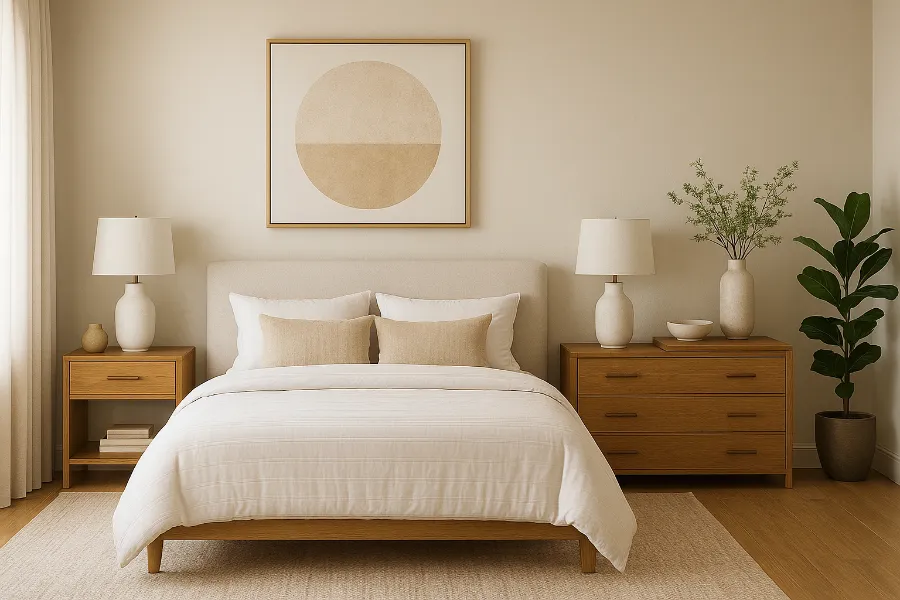
Once the bed is placed, focus on movement. A bedroom should allow easy circulation—not a maze.
Protect essential walkways:
- Entry to bed
- Bed to closet
- Bed to bathroom
- Bed to dresser or seating area
Avoid placing large furniture in locations that block paths. If you must choose between more storage and more comfortable movement, movement usually wins.
Height variation adds interest:
- A tall wardrobe paired with a mid-height dresser and lower bed frame adds visual layering.
- If everything is the same height, the room can look flat or monotonous.
How Rugs Help Ground and Balance the Room
Rugs act like a visual foundation. When placed correctly, they connect the bed to the rest of the room, making the space feel cohesive.
Ideal rug placement:
- The rug should extend under the bed.
- It should reach outward enough that your feet land on it when getting up.
- Aim for 18–24 inches extending beyond the bed on each side.
A rug that is too small makes the furniture feel scattered. A rug that is large enough ties everything together into one visual zone.
Lighting Balance and Room Atmosphere
Light influences both mood and depth perception. A single harsh overhead light can make a bedroom feel flat, while layered lighting builds warmth and dimension.
The U.S. Department of Energy notes that layering soft, energy-efficient lighting improves comfort and clarity in home environments.
Aim for three types of lighting:
- Ambient: Room-wide light, often ceiling or overhead.
- Task: Reading lamps, bedside lighting, desk lights.
- Accent: Warm corner lamps, wall sconces, soft indirect lighting.
The goal is gentle illumination that supports relaxation.
Art and Decor Proportion
Wall art and decor serve to anchor sight lines and guide visual flow. A room with furniture but no art can feel unfinished. A room with too many small items can feel chaotic.
Balance tips:
- One large piece above the bed often looks more balanced than many small pieces.
- If using multiple frames, group them tightly to create a single visual unit.
- Use tall decor (plants or standing lamps) to offset heavy furniture.
Visual balance comes from how pieces relate to each other, not their individual size.
Managing Clutter While Keeping the Room Welcoming
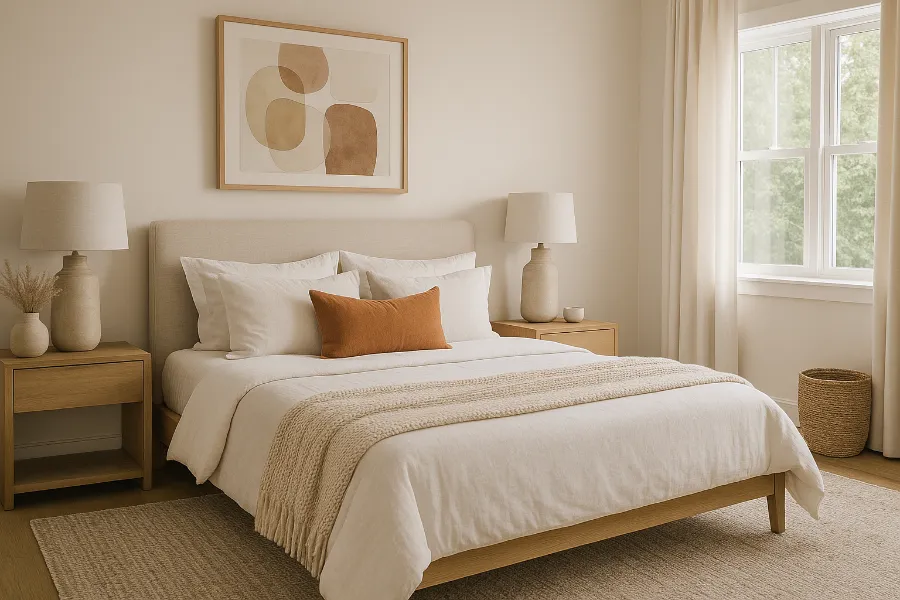
Even with perfect furniture placement, clutter can disrupt balance instantly. Bedrooms benefit most from storage that is easy to maintain and visually calm.
Helpful storage habits:
- Choose nightstands with drawers.
- Use decorative baskets for loose items.
- Keep surfaces like dressers mostly clear except for a few meaningful or useful items.
- Use under-bed storage bins that are hidden rather than open.
Clutter prevention is less about owning nothing and more about giving everything a home.
Color and Texture for Harmonized Atmosphere
Color sets emotion. Texture sets personality.
For balanced visual proportion:
- Use soft or neutral tones for walls and bedding foundations.
- Add color in controlled accents: pillows, art, throws.
- Mix textures such as cotton, linen, wood grain, ceramic, metal, and soft rugs.
Texture is what makes a room feel layered and lived-in rather than flat or overly staged.
Final Thoughts: A Room That Lets You Exhale
A balanced bedroom isn’t perfect it simply feels right. The space feels like you can breathe in it. The furniture supports movement rather than restricting it. The visual elements support rest rather than overwhelm.
If something feels off, assess:
- Bed placement
- Furniture size
- Lighting softness
- Art balance
- Movement pathways
Often, the simplest changes create the most meaningful improvements.
A bedroom is one of the few private spaces in daily life where the world fades for a moment. Let its layout support that peace.
FAQs
If the room feels visually calm and easy to move through, it’s likely balanced. Pay attention to how your eyes and body feel in the space.
Centering the bed helps create symmetry, but it’s not required. In small or uniquely shaped rooms, asymmetry can still look intentional.
A full or queen-size bed usually works best in smaller rooms, providing comfort without overwhelming the space.
Aim for at least 18–24 inches of walking space around the bed for comfortable movement.
Yes, especially if wall space is limited. Add curtains and a headboard to help visually anchor the bed.
The rug should extend at least 18–24 inches beyond the sides and foot of the bed to feel properly grounded.
Matching nightstands create symmetry, but mismatched ones can work if they share similar visual weight or height.
Use layered lighting: ambient overhead lights, bedside task lighting, and softer accent lighting for depth and comfort.
It may be visually cluttered. Reduce small décor items and keep surfaces clear to create visual breathing room.
Try rearranging layout, adding a well-sized rug, adjusting lighting, or simplifying visible décor.










